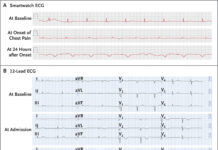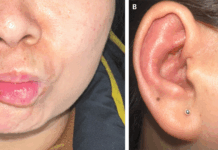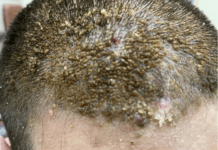
Malignant Ameloblastoma
Primary malignant ameloblastoma is defined as a rare tumour of the dental lamina epithelium. it is similar to benign ameloblastoma but without any significant histological atypia. Whereas the malignant type also presents with metastases, commonly in the lungs. The prevalence is equal in both men and women. The average age of diagnosis is 34 years but because of how rare the lesion is there is currently no standard of care.
Case presentation
In a similar case, a 38-year-old woman presented with constant right-sided abdominal pain with a palpable mass, significant weight loss and ascites. Doctors advised a CT scan which showed a large complex cyst, measuring 21.9 x 14.4 x 17.3 cm in the lateral right lobe of the liver. Doctors suspected bacterial or parasitic infection. However, biopsy and cultures ruled out the diagnoses.
A few years later the patient presented to the same facility with large ameloblastoma involving the jaw, neck and floor of the mouth. The mass measured 30 cm x 30 cm laterally, weighing over 1 kg. In addition, the mass contained both soft tissue and numerous ossifications. The mass had also spread to the mandibular molars and premolars, protruding anteriorly from the mouth with floating teeth. It was also impacting her speech and eating. However, there were no signs of invasion of the maxillary teeth and tongue. The tumour was further seen encompassing the entire mandible down to the lower tracheal region, inferiorly displacing the lower lip to the chest. The mass was removed surgically. Postoperatively, the patient developed left-sided deep vein thrombosis and a pulmonary embolism. Although the patient returned to Haiti without appropriate anticoagulation therapy.
Two years later the patient returned to the medical centre with another mass
The mass had recurred in the floor of the mouth involving the deep strap muscles of the neck and minor salivary glands. Although there were no signs of mandibular infiltration. The mass was vascular and showed rapid growth.
The malignancy recurred in the floor of the mouth, deep strap muscles of the neck and minor salivary glands. However, there were no signs of mandibular infiltration. The mass showed rapid growth and appeared one-third the size of the original mass. She had no history of smoking, drinking or family history of malignancies. 3 days after treatment, she experienced shortness of breath. She went back to Haiti without resolution of symptoms and did not return for chemotherapy. She passed away in 2020 presumably because of complications of metastatic ameloblastoma.
Source: America Journal of Case Reports



